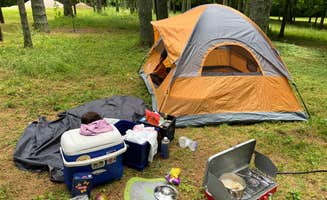Primitive camping near Ripley, West Virginia offers options across the Ohio border in Wayne National Forest. The region features rolling hills with elevations ranging from 650 to 1,200 feet, creating varied camping terrain. Summer temperatures typically reach 80-90°F with high humidity, while spring and fall camping provides more moderate conditions in the 60-70°F range.
What to do
Horseback riding trails: Kinderhook Horse Trail provides dedicated equestrian routes with regular maintenance. One visitor noted, "Nice trails. Seem to be well maintained," making this a good option for those traveling with horses.
Hill hiking: The Paw Paw trail near Kinderhook Horse Trail offers a less challenging alternative to other routes in the area. According to a camper, "The Paw Paw trail was very smooth, dry and wide. The trail leads to the top of the hill," making it accessible for most fitness levels.
Boulder climbing: The rocky terrain near Witch's Peak provides natural climbing opportunities. A visitor mentioned, "There are several boulder routes as well," indicating options for climbing enthusiasts beyond just hiking.
What campers like
Privacy variations: Site selection impacts the camping experience significantly. Some campers report mixed privacy levels, with one noting, "The site itself is quite nice, with access to toilets and picnic tables. However, it also seems to be a spot locals visit quite a bit."
Rock formations: Geological features near Witch's Peak create natural shelters. One camper commented, "At the end of the short trail is a cool rock shelter! A very neat local treasure," providing both protection and scenic interest.
Clean facilities: The maintenance of camping areas varies, with Kinderhook Horse Trail receiving positive mentions for its upkeep. A visitor observed, "Nice clean area just off main road," making it suitable for those prioritizing maintained facilities.
What you should know
Safety considerations: Solo campers should exercise caution at certain locations. One traveler warned, "I would not recommend this site if you are traveling solo," due to unexpected vehicle traffic.
Water availability: Manual pumps provide the only water source at some locations. Campers should note that while Kinderhook Horse Trail has "a small hand pump water spigot," most other dispersed sites have no water access.
Trail conditions: Path maintenance varies significantly across locations. One camper reported, "The Kinderhook trail was overgrown," indicating the need to research current trail status before visiting.
Insect presence: Bugs are prevalent in warmer months. A camper mentioned, "A lot of insects, humid and dense deciduous forest surrounding the trailhead," suggesting proper insect protection is essential.
Tips for camping with families
Site selection: Choose locations with basic facilities for younger campers. Kinderhook provides "flat tentspots" near amenities, making it more suitable for families with children.
Bathroom considerations: Vault toilets vary in cleanliness and comfort. One camper observed the bathroom was "clean, but the 'non-flush' toilet was just gross," suggesting families should bring sanitation supplies.
Traffic awareness: Some camping areas experience unexpected visitor patterns. A camper reported, "People coming and going every 15 minutes ish. Some folks pull in stare at you for a few seconds then leave," which may create an uncomfortable environment for family camping.
Trail difficulty assessment: When planning hikes with children, consider the terrain carefully. Witch's Peak presents challenges as "the trail in is super steep," which may prove difficult for younger hikers.
Tips from RVers
Size restrictions: Most dispersed camping in this region accommodates only smaller vehicles. A camper noted Kinderhook is "Definitely only for very small camper, car camp, or tent, small group," limiting options for larger RVs.
Parking distance: Vehicle access varies by location and vehicle type. At Kinderhook Horse Trail, "Parking for regular cars is 100 yards before restroom," requiring campers to transport gear this distance to tent sites.
Weather preparedness: The region experiences sudden weather changes. One RVer mentioned, "I did not camp here due to severe weather warnings," highlighting the importance of monitoring forecasts.


